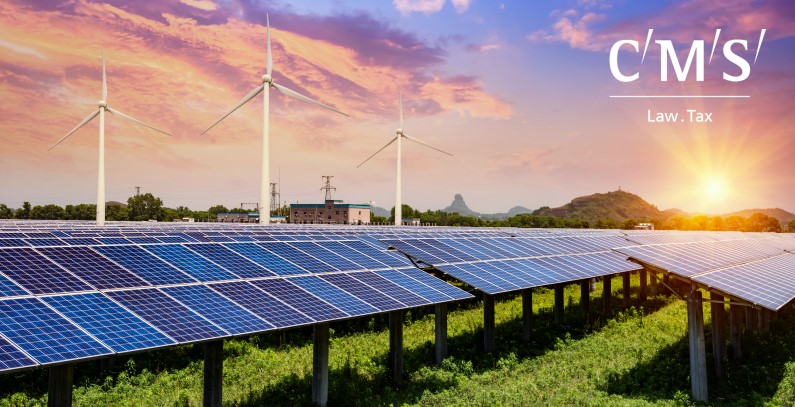
Photo: CMS
Authors: Louise Dalton, Partner, CMS London; Ivan Gazdić, Partner, CMS Belgrade; Igor Đorđević, Attorney-at-Law, CMS Belgrade; Charlotte Rihoy, Trainee Solicitor, CMS London
To date, renewable energy projects in the Balkans have been supported by traditional feed-in tariff subsidy schemes (FiT). Certain Balkan countries (e.g. North Macedonia and Bulgaria) have begun to implement alternative schemes, such as feed-in premiums (FiP), with other countries expected to follow suit. Others, such as Serbia, are seriously considering a transition to competitive auctions.
Over the past few years, measures have been introduced to diminish subsidy support, which has had an impact on the bankability of renewable energy projects in the region. In Bulgaria, for example, a twenty percent levy has been introduced on solar and wind farm revenues and the amount of energy that can be purchased at preferential FiT rates reduced. More recently, in Serbia, the government has temporarily suspended the payment of renewable energy subsidies following a state of emergency declared due to COVID-19.
Against this backdrop of diminishing financial support from governments, zero-subsidy and market-driven models for renewable energy projects are increasingly being explored. One alternative to state subsidy schemes is the corporate power purchase agreement (PPA).
What is a corporate PPA?
Organisations around the world are increasingly looking to reduce their carbon footprint, often through switching to renewable energy sources to power their business. One means of doing this is via a corporate PPA. It is a contract between a power user and a power producer, whereby the parties agree to buy and sell power at a pre-agreed pricing mechanism for a given time period. The contract governs the commercial terms of the electricity sale. Under a corporate PPA, the buyer is a business with often significant import electricity requirements, as opposed to a utility company purchasing power for onward selling to customers.
Under a corporate PPA, an offtaker can purchase power either from an on/near-site project (known as behind-the-meter and private wire respectively) or from an offsite project (known as corporate PPAs).
Behind-the-meter and Private Wire
In this scenario, a company enters into a behind-the-meter or private wire PPA, whereby the generator installs a renewable asset at or near the company’s site. The company receives electricity via a private connection, bypassing the wider electricity network. Importantly, the third-party developer will usually retain ownership of, and operational risk associated with, the generation asset.
Depending on the jurisdiction, bypassing the network may mean the corporate can avoid network and other charges on the electricity provided by the generation asset. Proximity to the company’s operations may limit the size of the project due to space constraints.
Corporate PPA
Here, a corporate contract to buy power from a renewable asset located in a different location. The arrangement will either be sleeved, involving an actual exchange of power, or virtual and solely financial in nature. Sleeved and virtual PPAs are discussed in more detail below. The generating asset may be pre-existing, or a new build project reliant on the corporate PPA revenue in order to secure the capex to construct the asset.
Since the project is connected to the network, network charges will apply, however, the project will unlikely be subject to the same size constraints, which also means a wider range of technologies are viable.
Corporate PPAs offer a number of advantages and challenges to both developer and corporate. These are discussed below.
Why are corporate PPAs attractive to developers?
Business diversification and risk mitigation
Corporate PPAs allow developers to diversify their revenue streams. Traditionally, developers have sold electricity directly to utility offtakers whose central business is the buying and selling of power. Corporate PPAs give developers direct access to offtakers spanning different sectors and geographies, with companies such as McDonald’s, Apple, Amazon, HSBC and Coca-Cola already having elected to purchase at least some of their power in this way. Power generators must contend with offtake risk – the possibility of not being paid for the power they produce due to uncertain demand. Corporate PPAs mitigate this risk, creating a guaranteed income stream for power generators in return for an amount of power produced.
Bankability
Corporate PPAs with creditworthy buyers offer a reliable, long-term income stream that can increase lender appetite to finance the renewable project. The typical term of a corporate PPA exceeds 10 years. This is increasingly important as subsidies for renewables projects reduce and projects are facing increasing merchant power price risk.
Brand building
Corporate PPAs with high-profile, like-minded businesses can enhance a generator’s brand though helping household names to go green. This, in turn, can have a positive impact on the share price.
Why are corporate PPAs attractive to corporates?
Price certainty
Under a corporate PPA, the offtaker has (depending on the pricing mechanism chosen) certainty as to their power price over a given period, thus mitigating against the risk of volatile energy prices (subject to the issue of imperfect hedging under a virtual PPA, discussed below). If the offtaker partakes in an emissions trading regime, then a corporate PPA may help to offset the price of carbon.
Operational risk
By enabling the construction of a new-build project via a corporate PPA, the offtaker avoids development, construction and operational risks and costs which it would otherwise be subject to if investing in a renewables project directly, meaning that resources can be focussed on the core business activity of the corporate.
Sustainability and brand
Corporates are coming under increasing pressure from governments, shareholders and the general public to reduce their carbon footprints. A group of companies known as RE100, which includes household names across a range of sectors such as IKEA, Apple, Bloomberg and eBay, have already made commitments to match 100% of electricity used across their global operations from renewable sources by certain dates. Against this backdrop of a shift towards emissions reduction, corporate PPAs provide an opportunity for companies to take carbon-reducing steps and, importantly, be seen to be doing so. This can help guard against emissions-related backlash and positively impact the brand.
Different corporate PPA structures
Sleeved PPA
Where both the renewable energy asset and the corporate are connected to the same or connected networks, a sleeved structure can be used. A sleeved structure involves the physical delivery of power. It is a tripartite arrangement, involving the generator, the corporate and a utility company that manages the delivery of electricity from one to the other.
The generator enters into a corporate PPA with the corporate, agreeing a price at which they will buy and sell electricity generated by the asset. A utility company is appointed to act as intermediary between the generator and the corporate. The generator sells the electricity to the corporate, which then sells it on to the utility company, with which it has entered into a back-to-back PPA. The utility company handles the delivery of power from the network to the corporate, selling the power back to them and charging a sleeving fee for the service.
Under a sleeved structure, the corporate buys electricity directly from the generator. Electricity flows from the generator to the utility company, to the corporate. Money flows from the corporate to each of the generator and the utility company.
Risks associated with sleeved PPAs
Under a sleeved PPA, the offtaker has contracted to buy power from a specific renewable asset. Where this asset does not perform as expected, either due to construction delays or the inherent uncertainty in delivery associated with certain renewable sources e.g. wind and solar, the buyer’s power needs may not be met. The mismatch between power demand and supply is known as balancing risk. In order to guard against this risk, balancing risk is usually addressed in the agreement between the utility company and the corporate.
Virtual PPA
Under a virtual PPA structure (also known as financial or synthetic), there is no need for the generator and the offtaker to be connected to the same network since no physical power exchange actually takes place. The virtual approach is a financial arrangement whereby the electricity user and producer can hedge against volatile market prices. Unlike a sleeved PPA, a virtual PPA does not require the involvement of a utility company.
The corporate and the generator enter into a PPA, agreeing the price of electricity over a given period of time. Separately, the generator delivers energy to, and the corporate buys energy from, a local utility company at the varying market price.
The generator and the corporate, between themselves, then settle the difference between the market price and the strike price agreed in the PPA. Where the market price is higher than the strike price, the generator will pay out the difference to the corporate. When the market price is lower, the corporate will pay a top-up amount to the generator.
Risks associated with virtual PPAs
Under a virtual PPA, the generator and offtaker may be located in different energy markets. PPA payments will be linked to the power price in the generator’s market. Where the wholesale price in the generator’s market and the retail price in the supplier’s do not fluctuate together, there will be an imperfect hedge and the buyer will remain exposed to retail price volatility. Careful consideration should therefore be had to correlations between the two markets if this is the case. As a financial instrument, the financial services regulatory and accounting requirements in the relevant jurisdictions also need to be analysed.
Key considerations for corporate offtakers
Allocation of resources to non-core area
Acquiring power via a corporate PPA will likely require more resources than traditional power purchase from a utility company. The corporate will need to:
- understand key aspects of the electricity sector, which may include multiple markets in the case of a virtual PPA;
- decide as to which PPA structure is best suited to their needs;
- manage a competitive procurement process; and
- obtain necessary internal approvals.
The corporate should ensure that it has factored in this resource allocation away from core business.
Tendering process
There is no benchmark price for power under corporate PPAs, so a corporate will need to carefully consider what price works for them. A tendering process helps to identify a competitive price within the corporate’s parameters.
Power price forecasts
However, a tendering process cannot mitigate against sudden shocks to power prices (e.g. COVID-19) or longer-term power trends. Companies considering a long term corporate PPA will look to power price forecasts to help inform their decision. The more forward-looking a forecast is, the more susceptible it is to error, meaning parties to a fixed price PPA may find themselves paying over market value for their power for an extended period (although the converse is also true).
Change in power demand
Although shorter contracts can be agreed, most corporate PPAs are for ten years or more. A company’s power demand can fluctuate significantly over this time period. Companies should consider mitigating against the risk of committing to purchase more power than required in the future by taking on less than the current demand, entering into a short term PPA or including drafting in the contract to allow for assignment of the buyer’s rights, pre-agreed exit fees or adjustment to power volume.
Accounting treatment of PPA
The accounting treatment of a corporate PPA is fact-specific, depending on the regulations in place and contractual wording of the agreement. Specialist advice should be sought to ensure that the PPA does not have unforeseen consequences for the offtaker’s balance sheet.
Regulatory and competition law restrictions
Regulations and laws impacting corporate PPAs will need to be analysed on a case-by-case basis, however there may be restrictions on a non-utility corporate purchasing power directly from the generator or competition rules against a large energy consumer committing to purchase power from a single source.
Considerations for generators
Potential delay
Corporate PPAs are expanding the pool of buyers to whom generators are selling their power. Access to this wider spectrum of offtakers has significant benefits for the generator, as discussed above, but can also lead to delay during the earlier stages of a transaction, where the generator must take time building an understanding of the corporate’s requirements and negotiating the PPA with a party for whom this is unfamiliar territory. In some cases, the delay outweighs the benefits.
Corporate’s creditworthiness
The corporate’s creditworthiness is crucial to the generator, not only with a view to getting paid under the contract but also because an offtaker with a strong credit rating is more likely to attract financial support for the project from prospective lenders. Establishing equivalent credit support were the corporate’s creditworthiness to decline is vital.
Power price
As with the offtaker, the generator will have pricing requirements in order to secure the funding for the project. Various pricing mechanisms, including fixed pricing, cap and collars and floors can provide the generator and its funders with greater certainty.
Opposing needs of the lender and the buyer
It will usually fall to the developer to help resolve conflicts between the demands of a prospective lender and corporate buyer. For example, the lender will usually want the PPA term to match the debt term, which can impact available finance where the corporate is looking for a short-term PPA.
Progressing corporate PPAs in the Balkans
The treatment of corporate PPAs throughout the different Balkan countries varies.
EU Member States
The use of corporate PPAs throughout the European Union is being encouraged under the Renewable Energy Directive (RED II), which requires that EU member states identify and remove unnecessary barriers to the facilitation and uptake of corporate PPAs. Implementation of RED II should be completed by 30 June 2021.
The position in respect of corporate PPAs varies across the Balkans. In Slovenia, corporate PPAs are permissible under the current legislation, although not explicitly regulated.
The approach in Croatia is more restrictive than in Slovenia. Corporate PPAs do not currently seem to be permissible, save for virtual structures between the generator and the corporate providing price hedging.
Similarly, corporate PPAs are not specifically regulated in Bulgaria. Generally, all electricity produced in Bulgaria is sold through IBEX (Independent Bulgarian Energy Exchange). A generator wishing to sell energy directly to an energy user should do so through IBEX with the assistance of a licensed electricity trader. Although there is no specific regulation of corporate PPAs, the Bulgarian Energy Act provides certain options for direct purchase of energy from renewable producers with plants put into operation after 1 January 2019. Currently, corporate PPAs are gaining popularity, however none have been executed.
EU Member State Candidates and Potential Candidates
Although corporate PPAs are not explicitly regulated in Bosnia and Herzegovina, there seems to be no formal impediment to their execution. The non-existence of corporate PPAs in Bosnia and Herzegovina to date is mainly due to the fact that most of the generators are still enjoying the benefits of FiTs.
In Serbia, entering into certain forms of corporate PPA should be permissible under the current legislation. Serbia, as a contracting party to the Energy Community Treaty, is obliged to implement core EU energy legislation. The Serbian Energy Act will therefore likely be aligned with RED II, enabling the legal framework to facilitate corporate PPA uptake in Serbia.
In North Macedonia, consumers who qualify for independent participation in the electricity market can also buy electricity from generators (including generators of renewable energy). Further, on-site PPAs have been deployed, for example a developer has installed a photovoltaic power plant on the roof of an industrial facility and then selling that electricity directly to the factory.
Conclusion
Corporate PPAs can provide a number of benefits to both the generator and the corporate, particularly as markets move to a post-subsidy world and achieving “net zero” is increasingly expected by the customers of large corporates. Whilst the impact of COVID-19 and the related uncertainty may somewhat delay certain projects, we nevertheless predict a significant increase in interest in such structures across the region.
For more information on corporate PPAs, contact your regular CMS advisor or the authors of this article.


















Be the first one to comment on this article.